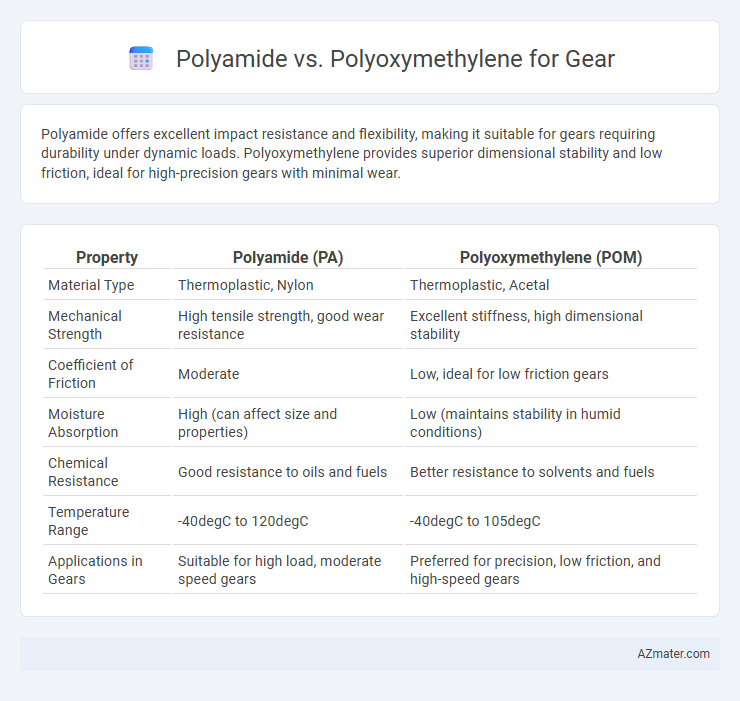Polyamide offers excellent impact resistance and flexibility, making it suitable for gears requiring durability under dynamic loads. Polyoxymethylene provides superior dimensional stability and low friction, ideal for high-precision gears with minimal wear.
Table of Comparison
| Property | Polyamide (PA) | Polyoxymethylene (POM) |
|---|---|---|
| Material Type | Thermoplastic, Nylon | Thermoplastic, Acetal |
| Mechanical Strength | High tensile strength, good wear resistance | Excellent stiffness, high dimensional stability |
| Coefficient of Friction | Moderate | Low, ideal for low friction gears |
| Moisture Absorption | High (can affect size and properties) | Low (maintains stability in humid conditions) |
| Chemical Resistance | Good resistance to oils and fuels | Better resistance to solvents and fuels |
| Temperature Range | -40degC to 120degC | -40degC to 105degC |
| Applications in Gears | Suitable for high load, moderate speed gears | Preferred for precision, low friction, and high-speed gears |
Introduction to Engineering Plastics for Gears
Polyamide and polyoxymethylene are two commonly used engineering plastics for gears, each offering distinct mechanical properties and performance benefits. Polyamide, known for its excellent wear resistance and impact strength, provides good fatigue endurance and chemical resistance, making it suitable for dynamic gear applications. Polyoxymethylene exhibits superior dimensional stability, low friction, and high stiffness, which ensures precise gear operation and reduced energy loss in high-load, high-speed environments.
Overview of Polyamide (Nylon) and Polyoxymethylene (POM)
Polyamide (Nylon) is a versatile engineering thermoplastic known for its excellent mechanical strength, wear resistance, and good chemical resistance, making it suitable for durable gear applications. Polyoxymethylene (POM), also called acetal, offers superior dimensional stability, low friction, and high stiffness, ideal for precision gears requiring minimal backlash and noise. Both materials excel in mechanical performance, but Nylon provides better impact resistance, while POM delivers enhanced hardness and excellent machining capabilities.
Mechanical Properties Comparison: Strength and Stiffness
Polyamide exhibits higher impact resistance and better fatigue endurance, making it suitable for gears requiring toughness and flexibility, while polyoxymethylene (POM) offers superior stiffness and tensile strength, enabling precise gear performance under load without deformation. POM's low moisture absorption enhances dimensional stability and maintains mechanical properties, whereas polyamide's higher moisture uptake can reduce strength and stiffness over time. In applications prioritizing rigidity and wear resistance, POM is ideal, whereas polyamide is favored for gears needing shock absorption and resilience.
Wear Resistance and Durability in Gear Applications
Polyamide exhibits excellent wear resistance due to its high toughness and self-lubricating properties, making it suitable for gears operating under moderate loads and speeds. Polyoxymethylene (POM), also known as acetal, offers superior dimensional stability and lower friction coefficients, resulting in enhanced durability and wear resistance in high-precision, high-load gear applications. In gear manufacturing, selecting polyoxymethylene optimizes performance where long-term durability and minimal wear are critical, while polyamide is preferred for cost-effective solutions with decent wear resistance.
Friction and Lubrication Performance
Polyamide gears exhibit moderate friction levels and self-lubricating properties due to their inherent molecular structure, enhancing wear resistance under various load conditions. Polyoxymethylene (POM) gears offer lower friction coefficients and superior dimensional stability, resulting in smoother operation and reduced lubrication requirements. Both materials perform well in gear applications, but POM's enhanced lubrication performance makes it ideal for precision and high-speed mechanisms where minimizing friction is critical.
Dimensional Stability and Moisture Absorption
Polyamide exhibits higher moisture absorption rates, typically around 2-8%, leading to dimensional changes and reduced stability under humid conditions. Polyoxymethylene (POM), also known as acetal, offers superior dimensional stability due to its low moisture absorption, usually less than 0.2%, making it ideal for precision gear applications. The reduced water uptake of POM results in minimal swelling and consistent mechanical performance, whereas polyamide's hydrophilicity can cause warping and tolerance variations in gear components.
Thermal Resistance and Operating Temperature Ranges
Polyoxymethylene (POM) offers superior thermal resistance compared to Polyamide (PA), with an operating temperature range typically between -40degC to 120degC, while Polyamide functions effectively from -40degC to 90degC. POM's inherent low thermal expansion and high dimensional stability enhance gear performance under sustained heat exposure. Polyamide exhibits moisture absorption, which can reduce its thermal resistance and mechanical properties at elevated temperatures, making POM more suitable for high-temperature gear applications.
Machinability and Processing Considerations
Polyamide (PA) exhibits excellent machinability due to its good dimensional stability and lower melting point, allowing for easier cutting and shaping during gear production. Polyoxymethylene (POM), known for its high stiffness and low friction, requires precise machining parameters to avoid surface melting and improve finish quality. Processing considerations favor PA for complex shapes with less tool wear, while POM demands controlled cooling and speed to maintain structural integrity in gear applications.
Cost-Effectiveness and Material Availability
Polyamide gears offer high cost-effectiveness due to lower raw material expenses and widespread availability, making them suitable for mass production. Polyoxymethylene, while more expensive, provides superior mechanical strength and dimensional stability but may face limited supply in some markets. Choosing between the two depends on balancing budget constraints with performance requirements and ensuring consistent material sourcing.
Application Suitability: Choosing the Right Material for Gears
Polyamide offers superior impact resistance and excellent wear properties, making it ideal for gears subjected to dynamic loads and moderate temperatures. Polyoxymethylene (POM) provides higher stiffness, low friction, and excellent dimensional stability, suited for precision gears in high-speed, low-noise applications. Selecting the right material depends on gear requirements such as load conditions, environmental factors, and desired lifespan, with polyamide favored for durability and POM for precision performance.

Infographic: Polyamide vs Polyoxymethylene for Gear
 azmater.com
azmater.com